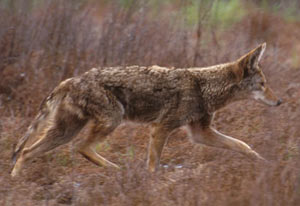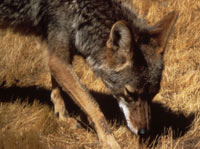 Description
Description
Coyotes possess typical canine features and generally resemble a small German shepherd dog. They have large erect ears, an elongated sharp muzzle and a long bushy tail. Overall pelt coloration tends to be brown or buff interspersed with mottled gray or black. The chin, throat, chest and stomach are usually a lighter shade of brown or cream. The lower frontal portion of the legs may display black stockings and the tail has a black tip. Non-typical color phases occur infrequently. The predominant pelage coloration of individual coyotes occasionally includes red or black and various gradients between the two.
Average adult weights range from approximately 30 to 40 lbs., with some individuals approaching 60lbs. Total length can exceed 60 inches, and shoulder height varies between 11/2 to 2 feet. Males may be 20% larger than females. Coyotes from the northeastern US tend to be significantly larger than those found west of the Mississippi River.
Distribution & Population Characteristics
Coyotes were historically a western species with core populations found west of the Mississippi River. Alterations and/or elimination of competing predators during the post-European colonization period facilitated rapid range expansion into eastern North America during the 20th Century. Established populations now occur in every state and province in North America.
Coyotes are a relatively new addition to local ecosystems and were first documented in Maryland in 1972. Initial substantiated sightings occurred in Cecil, Frederick and Washington counties. Since that time, population densities and occupied range have expanded incrementally and coyotes now occur statewide. Current trends appear to display a declining distribution gradient when proceeding in a west to east direction across the state with the highest densities in western Maryland and the lowest densities on the eastern shore.
 Natural History
Natural History
Coyotes reach sexual maturity by one year of age and normally remain fertile throughout their life. Breeding season encompasses late January through March, with peak activities occurring during February. Gestation periods extend approximately 60-63 days and litters average 5-6 pups.
The coyotes' rapid range expansion throughout North America substantiates their adaptability and ability to thrive in a variety of habitat types. In Maryland, coyotes occupy most of the state's habitat types with the highest densities occurring in intermixed woodland/farmland areas. However, it is probable that population densities will continue to increase in remaining habitat types, including Maryland's suburban corridor.
Coyotes also have extremely broad food habits. Dietary items range from plant material and insects to deer and domestic animals. Although small mammals (mice, rabbits, etc…) and birds are typically the most important food items during certain periods of the year, coyotes capitalize on seasonally and locally abundant food sources. During certain periods, insects and plants may predominate, while at other times carrion or live prey animals may be preferred.
Ecological Implications
Maryland and Delaware have the distinction of being the last two states in the contiguous United States to be colonized by coyotes. Maryland is quite fortunate to have the unique perspective of witnessing the ecological and social impacts of established coyote populations in other states. Regardless of geographic location, eastern coyotes all possess the same basic genetic material and exhibit essentially the same behavioral traits and population characteristics.
Impacts on natural communities are also fairly predictable and can negatively impact various native species. Establishment in unoccupied regions of the eastern US, coyotes have assumed the role of top-order predator. Consequently, they tend to fundamentally alter existing ecosystem structure and function. Various species have experienced population declines as a result of their status as coyote prey, or from direct competition for existing resources.
Culturally and ecologically significant species, including red fox, have been known to decline dramatically or be pushed into less favorable habitats in response to increasing coyote populations. Eastern coyote and red fox share many common habitat requirements and occupy overlapping niches. Through time, the larger and more resilient coyote is able to out-compete and displace resident red fox populations. As a result, red fox are typically delegated to existence in small areas devoid of individual coyote home ranges – often pushing the red fox into closer proximity to people.
Lesser changes are expected in gray fox, bobcat and other associated predator and prey populations. Long-term impacts on white-tailed deer are not completely known in the east. Coyote food habit studies regularly show consistent use of deer as food. However, it does not appear that coyote limit deer populations on a regional scale at this time.
Social Implications
Public opinion concerning coyotes evolves in a very predictable fashion. As coyotes first appear in an area, they are novel and receive a great deal of interest. As population densities and associated nuisance complaints increase through time, public opinion quickly changes from novel fascination, to "I do not want this animal in my neighborhood." Few, if any other, wildlife species evoke as widespread and passionate disdain by the general public as coyotes.
Livestock and crop depredation attributed to coyotes have been documented throughout North America. While livestock depredation by coyotes has occurred in Maryland, coyotes do not seem to be a major cause of agricultural loss in the state. Additionally, as coyotes become established in suburban areas, they may prey on local dogs and cats. In fact, a localized indicator of the presence of coyotes may be a rapid decline in the free ranging cat population. Once again, these negative impacts seem to be localized in nature with most coyotes preferring to avoid people.
Localized situations involving livestock loss can be addressed and problems either alleviated or resolved. After depredations have occurred, studies document that spot removal of offending animals is the most efficient solution. Husbandry techniques may mitigate some problems; nonetheless they are not an all inclusive panacea. Current management approaches recommend that improved husbandry practices be used in conjunction with a pro-active harvest control program. Technical information provided by the professional wildlife and/or agricultural communities is widely available, and when implemented can reduce the site-specific vulnerability of livestock to coyote depredations. Pet depredation can generally be mitigated by eliminating outdoor feeding of pets, keeping pets leashed, and accompanying pets outside.
Regulatory History
Prior to 1995, there was no mention of coyotes in Maryland statute or regulation and it was unclear what, if any, management options were permissible for this species. Realizing these inconsistencies, the Maryland Department of Natural Resources (DNR) supported legislation that provided for the legal classification of coyotes as a "Fur-Bearing Mammal," subject to several sunset clauses. This authorized the Department of Natural Resources to independently develop management strategies and harvest regulations for this species. Subsequent amendments prescribed certain management options to be instituted by DNR.
Specifically, these amendments allow for the incidental take of coyotes while a hunter is legally pursuing other game species, as well as a year round harvest season by predator calling. The amendments further authorized DNR to establish a trapping season for coyotes with harvest regulations determined by DNR. Trapping seasons are established annually by regulation and are concurrent with fox trapping seasons in individual counties.
During the 2000 legislative session, the General Assembly repealed the sunset clause provisions, thus affording the coyote permanent statutory classification as a "Fur-Bearing Mammal."
Management/ Research Activities
Annual hunting and trapping seasons for coyotes have been established. These harvest seasons allow DNR the flexibility necessary to proactively address some of the aforementioned ecological and social concerns. Additionally, they also supply the public with new and challenging recreational opportunities. Information about seasons, bag limits, and methods of take for coyote and other furbearers can be found in the Guide to Hunting & Trapping in Maryland.
DNR has been conducting an annual Archery Hunting Survey since the 2002-03 hunting season. This survey questionnaire was designed to capture observational data from archery hunters about furbearers and numerous other wildlife species. Respondents recorded the length of individual hunts and the species and number of animals observed during each hunt. The resulting data documents the number of animals viewed by species, and per hour, on a local and statewide basis. The repetitive design of this survey, and its relatively large sampling base, provides another tool that enables DNR to accurately estimate population trends on a yearly basis. This type of information furnishes the foundation for development of responsive harvest regulations for coyotes and other furbearers.
Coyote Problems
DNR has contracted with the USDA Wildlife Services to establish a public access nuisance animal hotline. Wildlife Service specialists are available to provide technical guidance or facilitate contacts with professional Nuisance Wildlife Cooperators. Individuals that are experiencing problems with coyotes or other wildlife species are encouraged to call (877) 463-6497.
Additional Information
The following books contain excellent technical information:
- Wild Mammals of North America: Biology- Management-Economics. J.A. Chapman and G.A. Feldhamer editors. Published by Johns Hopkins University Press, Baltimore Maryland.
- Wild Furbearer Management and Conservation in North America. M. Novak, J.A. Baker, M.E. Obbard, and B. Malloch editors. Published by the Ontario Trappers Association under the authority of the Ontario Ministry of Natural Resources, North Bay Canada.
